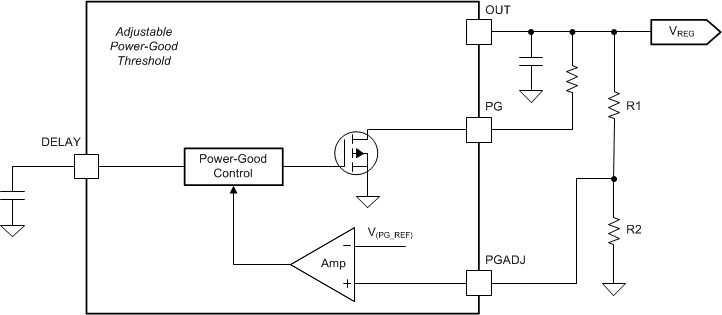SLVSEK5A August 2018 – October 2018 TPS7B70-Q1
PRODUCTION DATA.
- 1 Features
- 2 Applications
- 3 Description
- 4 Revision History
- 5 Pin Configuration and Functions
- 6 Specifications
- 7 Detailed Description
- 8 Application and Implementation
- 9 Power Supply Recommendations
- 10Layout
- 11Device and Documentation Support
- 12Mechanical, Packaging, and Orderable Information
Package Options
Mechanical Data (Package|Pins)
- PWP|16
Thermal pad, mechanical data (Package|Pins)
- PWP|16
Orderable Information
7.3.2 Adjustable Power-Good Threshold (PG, PGADJ)
The PG pin is an open-drain output with an external pullup resistor to the regulated supply, and the PGADJ pin is a power-good threshold adjustment pin. Connecting the PGADJ pin to GND sets the power-good threshold value to the default, V(PG_TH). When VOUT exceeds the default power-good threshold, the PG output turns high after the power-good delay has expired. When VOUT falls below V(PG_TH) – V(PG_HYST), the PG output turns low after a short deglitch time.
The power-good threshold is also adjustable from 1.1 V to 5 V by using an external resistor divider between PGADJ and OUT. Equation 1 calculates the threshold:

where
- V(PG_ADJ) is the adjustable power-good threshold
- V(PG_REF) is the internal comparator reference voltage of the PGADJ pin, 1.1 V typical, 2% accuracy specified under all conditions
By setting the power-good threshold V(PG_ADJ) when VOUT exceeds this threshold, the PG output turns high after the power-good delay has expired. When VOUT falls below V(PG_ADJ) – V(PG_HYST), the PG output turns low after a short deglitch time. Figure 21 shows a block diagram of this threshold.
 Figure 21. Adjustable Power-Good Threshold
Figure 21. Adjustable Power-Good Threshold